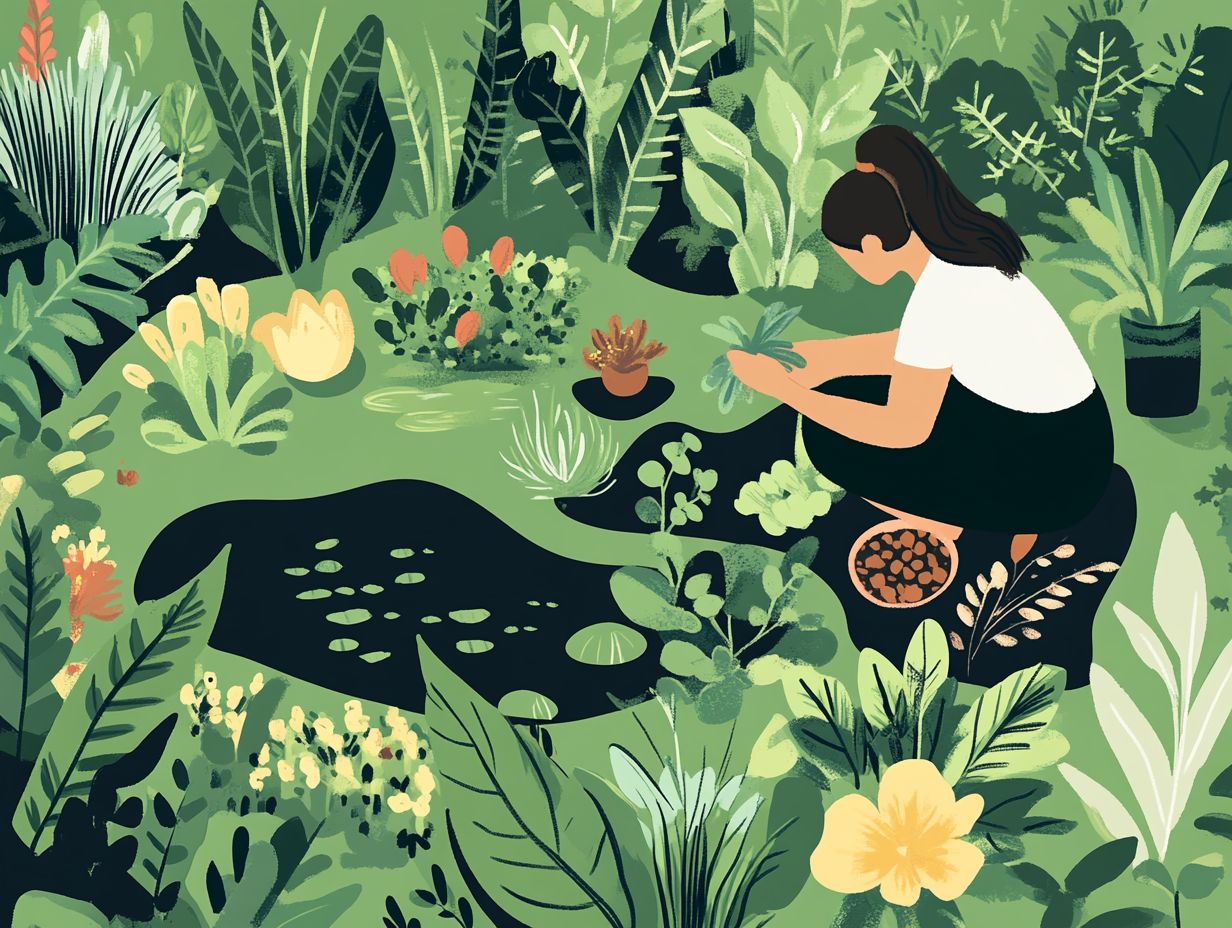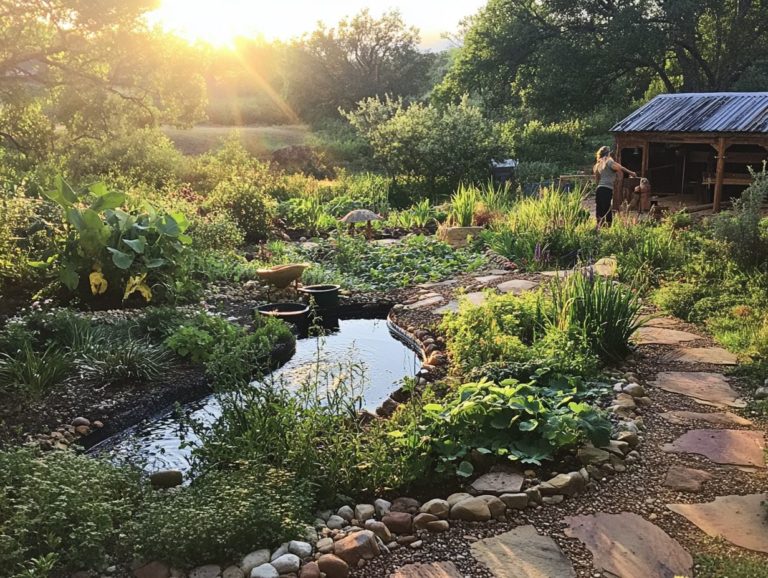How to Assess Your Site for Permaculture Design
Permaculture design presents a sustainable strategy for land use, highlighting the intricate balance between humanity and nature, which is essential for any ecological system.
This article delves into the foundational principles of permaculture, guiding you through the assessment of your site through sector analysis to foster a flourishing ecosystem.
You will also explore important aspects such as climate, soil quality, and effective water resource management, gaining valuable insights into integrating native flora and fauna, including the Mulberry, Pear Tree, and Black Walnut Tree into your design.
Join us to start creating your thriving permaculture landscape today! Cultivate a resilient and self-sustaining landscape that thrives in harmony with the environment, supporting both Earth and People.
Contents
Key Takeaways:

- Permaculture design is a sustainable approach to land management that works with rather than against nature.
- Assessing your site for permaculture design involves considering factors such as climate, soil quality, water resources, and flora and fauna.
- By understanding and working with the unique characteristics of your site, you can create a thriving permaculture system that supports both the environment and your needs.
Understanding Permaculture Design
Understanding permaculture design is essential for you as you seek to create sustainable agricultural systems that emulate natural ecosystems. This emphasizes resilient and efficient systems through careful observation.
By embracing the principles laid out by esteemed experts like Toby Hemenway, Pippa Buchanan, and Dan Halsey, you can effectively consider a range of factors, including site analysis, energy flows, and how different parts of the ecosystem work together through a deeper understanding of the permaculture design process.
In Kansas, where climate and soil conditions can differ significantly, talking with an expert designer at places like the Southwoods Center will enable you to customize permaculture strategies that cater to your unique environmental needs, ensuring enduring productivity.
Definition and Principles
Permaculture is a way of designing land that works with nature to create sustainable food systems. It aspires to cultivate sustainable and self-sufficient agricultural ecosystems, working in harmony with Earth, People, and Nature.
By integrating ecological principles, you can foster a harmonious relationship between Earth, People, and Nature while enhancing your overall design.
At its essence, permaculture revolves around a set of guiding ethics that empower you to nurture the land while honoring and enhancing the natural environment. These core ethics care for the earth, care for people, and fair share offer you a solid foundation for sustainable practices in alignment with permaculture.
You ll engage with concepts like zones, which help categorize the landscape based on how often it s visited and maintained, and sectors, which analyze external energies such as wind, water, and sunlight that influence your site.
By thoughtfully weaving together various elements from plants and animals like trees and shrubs to human communities you can create resilient habitats that not only support biodiversity but also promote ecological balance, while minimizing waste and decreasing reliance on non-renewable resources.
Assessing Your Site for Permaculture Design
Assessing your site for permaculture design is a crucial first step that requires a thorough site analysis and budget planning. This process allows you to grasp the specific climate, soil conditions, and water availability, alongside wind patterns that shape your ecological system.
By carefully evaluating factors such as wind patterns and microclimates within your space, you can craft a resilient design that optimizes natural resources while minimizing potential risks associated with climate variability. To learn more about this process, consider exploring the steps for creating a permaculture design. This approach boosts sustainability and increases your permaculture system’s productivity.
Key Factors to Consider
When assessing your site for permaculture design, focus on several key factors. These factors include climate, soil type, water accessibility, wind patterns, and microclimates. To ensure you cover all aspects, refer to a guide on creating a design checklist for permaculture.
Each of these elements plays a crucial role in shaping effective strategies for sustainable landscaping and enhancing your ecological system. Understanding the details of your climate, such as temperature ranges and precipitation patterns, enables you to select plant species that not only survive but thrive under specific conditions, including plants that survive with little water.
Soil type, with its unique properties and nutrient content, directly affects fertility and moisture retention, both critical for supporting a diverse array of plant life.
You must evaluate water accessibility, as adequate irrigation potential is vital for plant health, especially in drier regions like Kansas.
Wind patterns are also important; they impact plant growth and create natural barriers that aid in erosion control. Lastly, recognizing microclimates allows you to identify niches that can foster biodiversity, paving the way for a resilient ecosystem where plants flourish in harmony with the natural influences of your site.
Climate and Microclimate

The climate and microclimate of your region are crucial in shaping your permaculture design. They directly impact growth patterns, biodiversity, and the resilience of your agricultural system through effective wind and water management.
Understanding your local climate is essential for your project’s success don t miss this critical step! Consider factors like average temperatures, rainfall, and prevailing winds to create a thriving space that harmonizes with natural influences.
Microclimates, which can be found even in compact areas, offer unique opportunities for various plant and animal species to flourish. This ultimately enriches the ecological tapestry of your permaculture project while fostering resilience.
Impact on Permaculture Design
The impact of climate and microclimate on your permaculture design is profound. It shapes the types of plants that can thrive and the overall resilience of the ecological system you cultivate through informed design choices.
For example, if you re in a region with hot, dry summers, your design strategies will prioritize drought-resistant species and effective water management techniques.
Conversely, if you find yourself in an area with heavy rainfall, implement well-drained systems to prevent erosion and waterlogging, ensuring optimal soil health and moisture retention.
Paying attention to local wind patterns is equally crucial. Utilizing barriers like trees, such as the Black Walnut Tree, or shrubs can mitigate wind damage and create more favorable growing conditions for your plants.
By carefully observing specific characteristics of your environment such as shade availability or soil moisture retention you can craft a tailored approach that enhances biodiversity and optimizes yield. This all harmonizes with nature’s unique rhythms through sound ecological management.
Soil Quality and Management
Soil quality and management are essential elements of permaculture design. They serve as the backbone of a flourishing ecological system that nurtures plant growth and facilitates nutrient cycling within your permaculture project.
To assess soil quality, delve into its texture, composition, and fertility. Also, consider the ecological impacts of your management practices.
Implementing strategies like composting, mulching, and incorporating organic amendments can significantly bolster soil vitality while enhancing overall health.
By prioritizing soil health, you cultivate resilient systems that optimize resource use while fostering biodiversity and ecological balance.
Assessing and Improving Soil Health
Assessing and improving soil health in permaculture is essential for creating the ideal environment for thriving plant growth and enhancing your ecological system. For more insights, you can explore the essential elements for a permaculture design. Regular testing for pH, nutrient levels, and organic matter content serves as the foundation for this crucial process to ensure soil vitality.
To effectively evaluate your soil’s condition, consider utilizing comprehensive soil tests that pinpoint specific nutrient deficiencies and pH imbalances. This will contribute to informed management practices. Coupled with visual inspections, you can observe soil texture, microbial activity, and moisture levels, giving you a well-rounded view of its health.
Adding organic amendments such as compost, manure, or green waste can significantly elevate your soil quality and enhance its ecological contributions. Practicing sustainable techniques like crop rotation, cover cropping, and proper water management will replenish nutrients, prevent erosion, and enhance biodiversity.
By combining these strategies, you can cultivate a flourishing ecosystem that fosters healthy, resilient plant growth within your permaculture practices, ensuring long-term sustainability.
Water Resources and Management
Water resources and management are essential elements in permaculture design. They profoundly affect the viability and sustainability of your ecological system with effective strategies.
Implementing effective water management strategies such as rainwater harvesting, swales, and drip irrigation can significantly improve your capacity to conserve water. This ensures your plants receive the moisture they require, particularly in regions like Kansas.
By understanding and harnessing the natural water flows in your environment, you can create resilient systems that not only endure but thrive! Even in challenging conditions.
Utilizing and Conserving Water

Utilizing and conserving water in permaculture encompasses a variety of practices aimed at optimizing water use while minimizing waste. This supports the ecological balance of your design, creating a flourishing ecological system that nurtures diverse plant and animal life.
Among these methods, contour planting stands out as a crucial technique. It involves creating swales that capture rainfall, allowing it to gently seep into the soil instead of running off. This approach not only reduces erosion but also enhances groundwater recharge, cultivating a fertile environment for your crops.
Incorporating greywater recycling systems water that comes from sinks and showers allows you to efficiently repurpose this water, providing a sustainable irrigation source for your gardens.
By blending these techniques, you can cultivate a resilient and self-sustaining ecosystem. This underscores the significance of strategic water management in your everyday practices.
Flora and Fauna
In permaculture design, grasping the intricacies of flora and fauna is paramount. By adding native species, you enhance the resilience and biodiversity of your ecological system while nurturing a harmonious environment.
Choosing plants that are well-suited to local conditions allows you to cultivate a thriving ecosystem that supports diverse wildlife and promotes the natural equilibrium of the area. This approach boosts sustainable agriculture and improves the environment’s health.
Identifying and Incorporating Native Species
Identifying and incorporating native species into your permaculture design is essential for enhancing biodiversity and improving soil health. This creates a resilient ecological system that harmonizes with your local environment.
By choosing plants well-suited to Kansas s unique climate and soil, such as coneflowers, black-eyed Susans, and native grasses like big bluestem, you will create a vibrant habitat that attracts pollinators insects and birds that help plants reproduce and beneficial insects. These native species require less water and maintenance while promoting a natural balance, minimizing the need for chemical fertilizers and pest control.
To effectively integrate these plants into your permaculture system, start by:
- Carefully examining your land.
- Researching local ecosystems to pinpoint the best candidates.
Local ecological groups offer valuable insights and resources for successful implementation.
Frequently Asked Questions
How do I start assessing my site?
The first step is to gather necessary reference data such as topographical maps, soil tests, and climate information.
How do I find the best location for my permaculture design?

Consider factors such as sunlight exposure, water sources, and existing natural resources to identify the ideal location.
What key elements should I look for when assessing a site?
Important elements include slope, soil quality, water availability, and microclimates.
How can I check the health of my soil?
Conduct a soil test to determine pH levels, nutrient deficiencies, and overall soil health. Understanding these factors is crucial and aligns with the key elements of successful permaculture design, which will guide your design and planting choices.
What should I consider regarding the climate?
Consider the average annual temperature, rainfall patterns, and potential weather hazards like frost or drought. This information will help determine suitable plant species and design strategies.
Do I need special equipment to assess my site?
While tools like a soil probe or pH meter can be helpful, they are not necessary. Most information can be gathered through observation and research.






